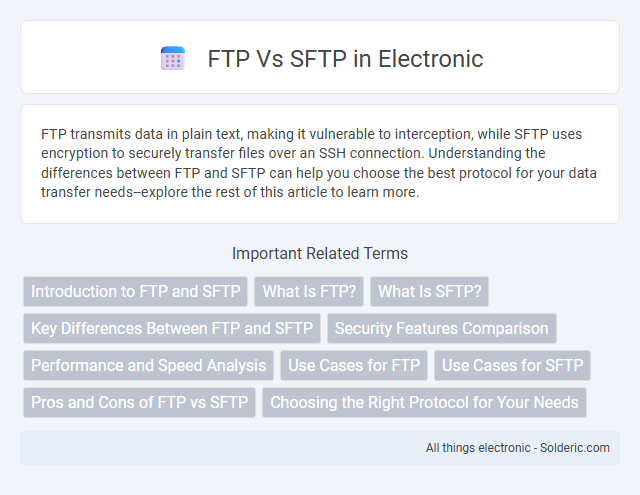FTP transmits data in plain text, making it vulnerable to interception, while SFTP uses encryption to securely transfer files over an SSH connection. Understanding the differences between FTP and SFTP can help you choose the best protocol for your data transfer needs--explore the rest of this article to learn more.
Comparison Table
| Feature | FTP (File Transfer Protocol) | SFTP (SSH File Transfer Protocol) |
|---|---|---|
| Security | Unencrypted data transfer | Encrypted via SSH |
| Port | Default port 21 | Default port 22 |
| Authentication | Username and password only | Username/password or SSH key authentication |
| Data Integrity | No built-in integrity checks | Ensures data integrity and confidentiality |
| Protocol Type | Application layer protocol | Subsystem of SSH protocol |
| Firewall Compatibility | Multiple dynamic ports can cause issues | Single port usage simplifies firewall rules |
| Performance | Faster in non-secure environments | Slower due to encryption overhead |
| Use Case | Legacy systems, non-sensitive data transfer | Secure file transfer in modern applications |
Introduction to FTP and SFTP
FTP (File Transfer Protocol) is a standard network protocol used for transferring files between a client and server over a TCP/IP network, operating on ports 20 and 21. SFTP (SSH File Transfer Protocol) provides a secure alternative by encrypting both commands and data using the SSH protocol, typically running on port 22. While FTP lacks inherent security features and transmits data in plain text, SFTP ensures confidentiality and integrity through strong encryption methods.
What Is FTP?
FTP (File Transfer Protocol) is a standard network protocol used to transfer files between a client and a server over a TCP/IP network. It operates on ports 20 and 21 and lacks encryption, making data vulnerable to interception during transmission. Understanding FTP's basic functionality helps you evaluate its suitability compared to more secure alternatives like SFTP.
What Is SFTP?
SFTP (Secure File Transfer Protocol) is a network protocol that provides secure file access, transfer, and management over a reliable data stream, typically SSH (Secure Shell). Unlike FTP, which transmits data in plaintext and lacks encryption, SFTP encrypts both commands and data, ensuring confidentiality and protection against interception or tampering. SFTP operates on a single port, usually port 22, simplifying firewall configuration and enhancing security for transferring sensitive information.
Key Differences Between FTP and SFTP
FTP transmits data in plain text, lacking encryption, while SFTP uses SSH encryption to secure file transfers. FTP operates over two separate channels for commands and data, whereas SFTP uses a single encrypted channel, enhancing security. Your choice between FTP and SFTP impacts data protection and compliance with security standards.
Security Features Comparison
FTP transmits data in plain text, making it vulnerable to interception and unauthorized access during file transfers. SFTP uses SSH encryption to secure data, ensuring confidentiality, integrity, and authentication throughout the transmission process. Unlike FTP, SFTP supports encryption of both commands and data, significantly enhancing protection against cyber threats.
Performance and Speed Analysis
FTP typically offers faster raw data transfer speeds due to its lack of encryption overhead, making it suitable for high-speed internal networks. SFTP incorporates encryption protocols like SSH, which introduce additional processing time, resulting in comparatively slower transfer speeds but enhanced security. Performance varies depending on network conditions and server capabilities, with SFTP favoring secure environments where data protection outweighs speed concerns.
Use Cases for FTP
FTP is commonly used for transferring large files between local networks or within an organization's trusted environment due to its simplicity and widespread support. It is ideal for scenarios where encryption is not a priority, such as uploading website content to a web server or sharing files in a controlled LAN setting. FTP servers often integrate easily with legacy systems, making them suitable for automated batch file transfers in enterprise workflows.
Use Cases for SFTP
SFTP (Secure File Transfer Protocol) is ideal for securely transferring sensitive data in industries such as finance, healthcare, and government, where encryption and compliance with data protection regulations are critical. Your organization benefits from SFTP when handling confidential files, performing automated backups, or integrating with remote servers that require strong authentication methods. This protocol ensures data integrity and protects against interception during transmission, making it the preferred choice for secure file exchange over FTP.
Pros and Cons of FTP vs SFTP
FTP offers faster file transfers and is widely supported, making it suitable for less sensitive data exchange; however, it lacks encryption, exposing data to potential interception. SFTP provides robust security through encryption and secure authentication, ensuring your files remain protected during transfer, but it can be slower and may require more complex server configurations. Choosing between FTP and SFTP depends on your priorities for speed versus security and compliance requirements.
Choosing the Right Protocol for Your Needs
FTP transmits data in plain text, making it less secure for sensitive information, while SFTP uses SSH encryption to ensure secure file transfers. Choose FTP for simple, high-speed transfers within trusted networks, and opt for SFTP when security, data integrity, and compliance with regulations are critical. Evaluating the environment, security requirements, and compatibility will guide the selection of the most suitable protocol.
FTP vs SFTP Infographic

 solderic.com
solderic.com